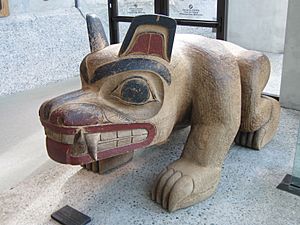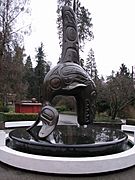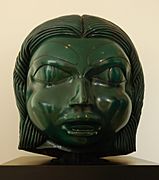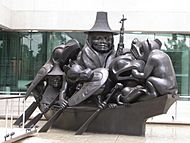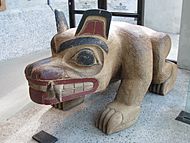Bill Reid facts for kids
Quick facts for kids
Bill Reid
|
|
|---|---|
| Born |
William Ronald Reid Jr.
12 January 1920 Victoria, British Columbia, Canada
|
| Died | 13 March 1998 (aged 78) Vancouver, British Columbia, Canada
|
| Nationality | Canadian |
| Occupation | sculptor, activist, environmentalist |
|
Works
|
The Spirit of Haida Gwaii Chief of the Undersea World |
| Awards | Order of British Columbia |
William Ronald Reid Jr. (born January 12, 1920 – died March 13, 1998) was a famous Canadian artist. He was a member of the Haida Nation, one of the First Nations groups in Canada.
Bill Reid created many different types of art. He made beautiful jewelry, large sculptures, screen prints, and paintings. Over his 50-year career, he made more than a thousand original artworks. Many people see him as one of the most important artists from the Northwest Coast of North America in the late 1900s.
Some of his most famous sculptures even appeared on the Canadian $20 banknote from 2004 to 2012.
Contents
Bill Reid's Life Story
His Early Years and Haida Roots
William Ronald Reid Jr. was born in Victoria, British Columbia. His father was from a Scottish-German background. His mother, Sophie Gladstone Reid, was from the Kaadaas gaah Kiiguwaay, Raven/Wolf Clan of T'anuu, part of the Haida people. The Haida are one of the First Nations groups living on the Pacific coast of Canada.
When Bill was young, he didn't know much about his Haida heritage. This was because of old government rules that made it hard for Indigenous people to keep their traditions.
In his early twenties, Bill visited Skidegate for the first time since he was a baby. Skidegate is an ancestral home of the Haida people. He really wanted to connect with his Haida family and learn about his Indigenous identity. He later said he was "looking for an identity which he had not found in modern western society."
While in Skidegate, Bill spent time with his grandfather, Charles Gladstone. His grandfather was a traditional Haida silversmith. Charles Gladstone taught Bill about Haida art. Bill even inherited his tools from his great-great-uncle, Charles Edenshaw. Edenshaw was a very famous Haida artist who passed away the same year Bill was born.
In 1944, Bill Reid married his first wife, Mabel van Boyen. In 1948, they moved to Toronto. There, Bill became even more interested in Haida art. He worked as a radio announcer for CBC Radio and studied how to make jewelry at the Ryerson Institute of Technology.
In his free time, he often visited the Royal Ontario Museum. He loved looking at a large carved Haida pole there. This pole came from his grandmother's village of T'aanuu. After finishing his studies, Bill made his first piece of jewelry inspired by Haida art. It was a bracelet, like the ones his aunts wore when he was a child.
In 1951, Bill Reid moved back to Vancouver. He opened his own art studio on Granville Island. He became very interested in the artworks of Charles Edenshaw. Bill worked hard to understand the symbols in Edenshaw's art. Many of these meanings had been lost over time, along with other Haida traditions.
During this period, Bill also helped save old Haida artifacts. He worked to protect many beautifully carved totem poles that were falling apart in abandoned village sites. He even helped rebuild part of a Haida village at the University of British Columbia Museum of Anthropology.
Bill started his art career making jewelry. He used traditional Haida shapes and modern materials like gold, silver, and argillite (a special black stone). Later, he began making larger sculptures. He used bronze, red cedar, and yellow cedar. His sculptures often showed figures, animals, and scenes from Haida mythology. He wanted to bring his ancestors' amazing art traditions into the modern world.
Famous Artworks
Bill Reid is most famous for three large bronze sculptures.
- Two of these sculptures show a canoe filled with human and animal figures.
- One is black and called The Spirit of Haida Gwaii. You can see it at the Canadian Embassy, Washington, D.C. in the United States.
- The other is green and called The Jade Canoe. It is located at the Vancouver International Airport in British Columbia.
- The third sculpture is called Chief of the Undersea World. It shows a jumping orca. This sculpture is at the Vancouver Aquarium.
You can also find plaster copies of these sculptures at the Canadian Museum of History in Gatineau, Canada.
His Amazing Legacy
Bill Reid received many awards and honors during his life. He was given special degrees from several universities, including the University of British Columbia and the University of Toronto.
In 1994, he received the National Aboriginal Achievement Award for his lifetime of amazing work. He also became a member of the Order of British Columbia and an Officer of France's Order of Arts and Letters. He was also made a member of the Royal Canadian Academy of Arts.
On April 30, 1996, Canada Post released a special stamp. It featured Bill Reid's sculpture The Spirit of Haida Gwaii. This stamp was part of the "Masterpieces of Canadian art" series.
Two of his sculptures, The Raven and the First Men and Spirit of Haida Gwaii, are shown on the $20 note. These were part of the Bank of Canada's "Canadian Journey" series from 2004.
Protecting Nature and His Final Journey
In his later years, Bill Reid took part in protests to protect the rainforests of Gwaii Haanas. He joined blockades of logging roads to help save these important forests. He even stopped working on his sculpture in Washington for a time to protest the destruction of the forests in Haida Gwaii.
In 1981, he married Martine de Widerspach-Thor. She was a French anthropologist.
Bill Reid spent the last part of his life creating new art and helping to care for existing artworks. He passed away on March 13, 1998, in Vancouver, after battling Parkinson's disease.
In July 1998, his friends and family paddled a large cedar canoe called Lootaas. Bill Reid had carved this canoe for Expo 86. They paddled for two days along the Pacific coast to bring his ashes to Tanu Island in Haida Gwaii. This island is the site of his mother's village, New Clew.
Gallery
-
Chief of the Undersea World, at the Vancouver Aquarium.
-
The Raven and the First Men, at the UBC Museum of Anthropology. This sculpture tells part of a Haida creation myth. The Raven is a clever trickster character in many myths.
-
Bear, at the UBC Museum of Anthropology.
See also
 In Spanish: Bill Reid para niños
In Spanish: Bill Reid para niños


